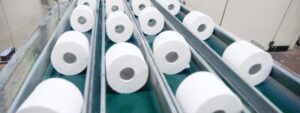
Ruta, a major Ukrainian manufacturer of sanitary and hygienic paper products, whose management company is VGP JSC (Lutsk), produced products worth UAH 417.4 million in January-March, up 8.2% compared to the same period in 2023.
According to Ukrpapir Association’s statistics provided to Interfax-Ukraine, in physical terms, in particular, the production of toilet paper in rolls increased by 1.7% to 31.9 million units, which remains the third result in the industry after Kyiv Cardboard and Paper Mill (64.5 million units) and Kokhava Paper Mill (37.7 million units).
Thus, in the first quarter, the company slowed its production growth rate in monetary terms compared to the same period in 2023, which amounted to 13.8% in the first two months. The growth rate of production in physical terms also slowed.
The company produces cellulose-based sanitary products from imported base paper.
VGP’s brand portfolio includes napkins, toilet paper, paper handkerchiefs, and kitchen towels under the Ruta, Ruta Selecta, Fesko, Nosovic, Polotenchko, 100% paper, Servetta, and Ecolo brands. The assortment includes more than 180 items.
As reported, in 2023, the company produced products worth UAH 1 billion 611 million, which is 64.8% more than in 2022.
According to the Clarity-project resource, in 2023, the company received UAH 185.2 million in net profit, up from UAH 3.6 million a year earlier.
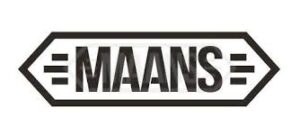
Production and design association “MAANS” (Rivne region), one of the largest manufacturers of equipment and spare parts, has increased production of agricultural machinery despite the war, reported the press service of Rivne regional military administration.
“Despite the war, the company has increased the production of its products by 2 times. Last year “MAANS” paid more than 31 million UAH of taxes to the budgets of all levels and ended the year with a profit. The wages of employees are gradually increasing. Today 140 workplaces have been created here”, – said the deputy head of the OBA Alexander Kohan.
“MAANS” has modern production facilities with an area of 9 thousand square meters. meters. There is equipment for cutting, bending, stamping, heat treatment, milling, welding and grinding of metal. There is a full cycle of production of cutterbars, carts for them, spare parts and consumables for them, noted in OBA.
The enterprise exports one-third of its production abroad. “MAANS” also joined the state platform “Made in Ukraine”: 27 units of equipment are in the list of the state program of compensation for the cost of agricultural machinery.
PE “VKO “MAANS” was registered in 2010 in Zdolbuniv, Rivne region. The authorized capital of the enterprise is 100 thousand UAH. Its beneficiaries are Stanislav Seredyuk (70%) and Igor Seredyuk (30%).
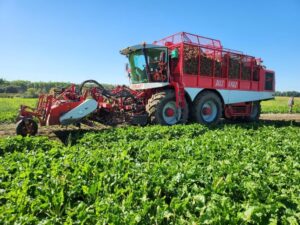
In 2023, Astarta Agricultural Holding produced 39 thousand tons of sugar beet, up 20% year-on-year, thanks to a record yield of 58 tons/ha compared to 56 tons/ha in 2022, the company said in its annual report on Wednesday evening.
According to the agricultural holding, the record high sugar beet harvest extended the processing period until the end of January 2024. In total, the sugar production campaign in 2023 lasted 130 days, compared to 111 days a year earlier.
“In the 2023-2024 marketing year, Astarta increased sugar production by 34% year-on-year to 377 thousand tons. At the same time, the volume of sugar beet processing in 2023 increased by 37% compared to the same period last year and reached 2.7 million tons. The market share remained unchanged at 21% in 2023, the document says.
The agroholding has engaged more than 100 independent sugar beet producers in eight regions of Ukraine to supply its sugar factories with raw materials. In 2023, they increased the supply of raw materials to 26% of the total volume of this crop processed by the company (18% a year earlier) – up to 707 thousand tons of the crop.
Astarta’s share in Ukraine’s total sugar exports amounted to 12%, or about 50 thousand tons in 2023. Italy and Romania became the key export destinations for the agricultural holding, accounting for 29% and 25% of the company’s exports, respectively. Hungary, Spain and Bulgaria were also among the top five buyers of Astarta’s sugar.
99% of Astarta’s sugar was exported by land, mainly by road (67%) and rail.
Half of the sugar produced was supplied to processing companies, primarily in the food industry, including confectionery, bakery and beverage production.
Astarta also produces by-products such as pressed pulp, dry granulated pulp and molasses from its sugar beet processing and sells them domestically as ingredients for animal feed production for use in its own livestock farming or for biogas production.
The volumes of by-products produced depend on the amount of sugar beet processed, so in 2023 their production volumes increased significantly, the agricultural holding explained. The production of molasses increased by 1.5 times to 98 thousand tons, and pressed pulp – to 1.7 million tons against 1.5 million tons in 2022. Production of granulated beet pulp amounted to 28 thousand tons.
In 2023, Astarta’s bioenergy complex used 145 thousand tons, or 9% of the produced pressed pulp, to produce biogas for its facilities. In addition, 223 tons (approximately 1%) of the produced granulated sugar beet pulp was used as alternative energy at one of the agricultural holding’s sugar plants.
Sugar sales volumes increased by 26% year-on-year to 284 thousand tons in 2023, while the average selling price increased by 3% to EUR 665/ton. Realized prices increased by 18% year-on-year to 26 thousand UAH/ton (excluding VAT).
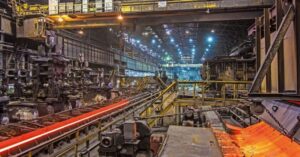
Dnipro Metallurgical Plant (DMZ, formerly Dneprokoks), a part of DCH Steel of businessman Aleksandr Yaroslavsky’s DCH Group, cut rolled steel production by 61% year-on-year in January-March this year, down to 11.5 thousand tons from 29.4 thousand tons.
According to a report in DCH Steel’s corporate newspaper on Thursday, coke output for the period increased by 52.4% to 69.8 thousand tons from 45.8 thousand tons.
At the same time, in March of this year, DMZ reduced rolled steel output by 41.3% year-on-year to 6.2 thousand tons. However, metallurgical coke production increased by 52.3% to 24.4 thousand tons.
“In March, rolled steel production increased by 17.9% compared to February and metallurgical coke production by 7.8%,” the publication states.
DMZ employees made a unique mine skip for the group’s Sukha Balka mine. It is specified that this lifting mechanism is unique because there are no other such mine skips in the world with a volume of 25 cubic meters and a lifting capacity of 53 tons from a depth of 1500 meters, usually miners use smaller units of 20 cubic meters.
The skip was transported to the mine, where it was covered with an anti-corrosion coating, galvanized and painted, and a lining made in Sweden was installed. Currently, the skip is being installed at Yubileynaya mine.
“The project to manufacture a mine roof was implemented as part of DMZ’s vertical integration with Sukha Balka mine. The work was done perfectly, so we decided to entrust DMZ specialists with the production of the next important unit – a three-storey mine cage,” said Vitaly Bash, CEO of DCH Steel.
As reported, in 2023, the plant increased its rolled metal output by 86.2% compared to 2022, up to 105.6 thousand tons, and coke by 38.5%, up to 292.7 thousand tons.
In 2022, the plant reduced rolled steel production by 74.2% compared to 2021, to 58.4 thousand tons, and coke production by 56.3%, to 211.3 thousand tons.
DMZ specializes in the production of steel, pig iron, rolled products and products made from them. On March 1, 2018, DCH Group signed an agreement to buy Dnipro Metallurgical Plant from Evraz.
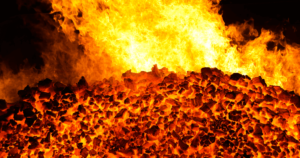
Zaporozhkoks, one of Ukraine’s largest coke and chemical producers and part of Metinvest Group, increased its blast furnace coke output by 1% year-on-year to 214.8 thousand tons from 211.3 thousand tons in January-March this year.
According to the company, it produced 74 thousand tons of coke in March.
As reported, Zaporozhkoks increased its blast furnace coke output by 16% in 2023 compared to 2022, up to 856.8 thousand tons from 737.4 thousand tons.
“Zaporozhkoks produces about 10% of coke in Ukraine and has a full technological cycle of coke products processing. It also produces coke oven gas and pitch coke.
“Metinvest is a vertically integrated mining group of companies. Its major shareholders are SCM Group (71.24%) and Smart Holding (23.76%), which jointly manage the company.
Metinvest Holding LLC is the management company of Metinvest Group.

Ruta, a major Ukrainian manufacturer of sanitary and hygienic paper products, whose management company is VGP JSC (Lutsk), produced products worth UAH 281.3 million in January-February, up 13.8% compared to the same period in 2023.
According to Ukrpapir Association’s statistics provided to Interfax-Ukraine, in physical terms, in particular, the production of toilet paper in rolls increased by 8.4% to 21.15 million units, which remains the third best result in the industry after Kyiv Cardboard and Paper Mill (42.5 million units) and Kokhava Paper Mill (24.3 million units).
The company produces cellulose-based sanitary products from imported base paper.
VGP’s brand portfolio includes napkins, toilet paper, paper handkerchiefs, and kitchen towels under the Ruta, Ruta Selecta, Fesko, Nosovic, Polotenchko, 100% paper, Servetta, and Ecolo brands. The assortment includes more than 180 items.
As reported, in 2023, the company produced products worth UAH 1 billion 611 million, which is 64.8% more than in 2022.